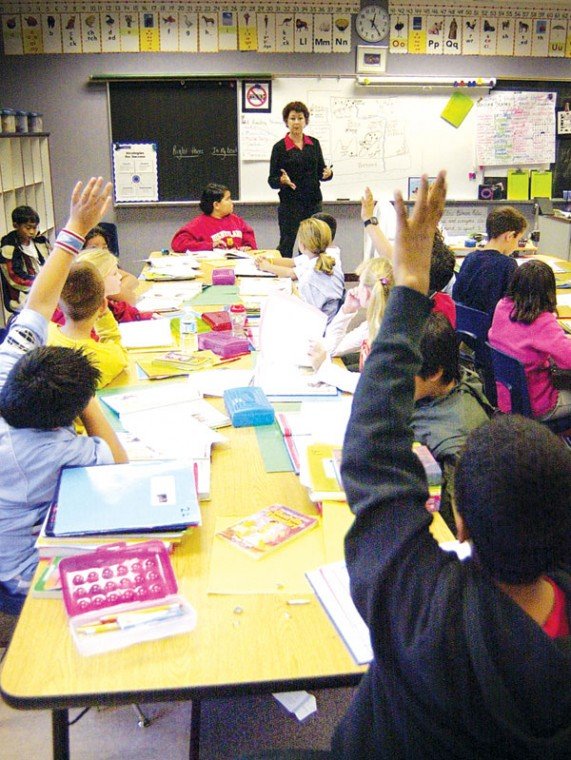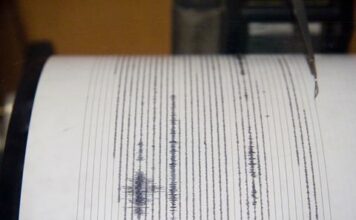Gilroy
– In a school district that is failing to progress as a whole,
Antonio Del Buono Elementary shines.
The school’s enthusiastic staff works as a team. Parents eagerly
involve themselves in their child’s educational experience, not
just when there’s a problem or because they feel they have to, but
because they want to.
Gilroy – In a school district that is failing to progress as a whole, Antonio Del Buono Elementary shines.
The school’s enthusiastic staff works as a team. Parents eagerly involve themselves in their child’s educational experience, not just when there’s a problem or because they feel they have to, but because they want to. There is a classroom focus on personal, interactive learning and both teachers and students are encouraged to push themselves to think about class material in new ways.
At Del Buono, the bar has been raised and the results are clear: state assessment scores for all three student subgroups – Hispanic, white and low-income – all jumped significantly by 24, 26 and 23 points respectively. Less than half of Santa Clara County’s 237 elementary schools hit targeted goals for all student subgroups.
ADB, as it’s affectionately known, is one of only three Gilroy schools that improved its 2003-04 Academic Performance Index scores enough to meet or exceed their goals set by the state Department of Education.
“I think where Del Buono is different is that teachers push themselves here, and that’s encouraged,” said Tammy Gabel, principal of Del Buono. “It’s OK to disagree. Everyone’s willing to participate, in teams, and be active in every part of running the school. There’s such a strength in collaboration.”
Gabel, who has served as principal since 2003 when lead principal Pat Midtgaard retired, attributes the school’s progress to a collaboration of staff and an open, non-hostile environment. Parent involvement and the school’s unique infrastructure also play a role, she said.
The school is nestled near Gilroy’s northern border a few blocks from busy Monterey Road. There are new homes, condos and apartments nearby and the school is flanked by green hills and mature trees. With 66 percent of its student body Latino and 22 percent white, Del Buono’s demographics fit between schools such as Glen View Elementary, which is 89 percent Latino and 6 percent white, and Luigi Aprea Elementary, which is a mix of 48 percent Latino and 36 percent white.
Strength in numbers
Teamwork at Del Buono is evident in the way teachers interact among themselves, with Gabel and with their students. The environment is welcoming and warm. Staff members are friends who work together, plan together and communicate with each other.
And this week, they enjoyed two homemade pumpkin pies that an anonymous staff member left in the breakroom, along with a couple of tubs of whipped cream.
Between bites of dessert, teachers spoke of how collaboration and friendliness are two core components of Del Buono’s staff. One teacher who worked at another Gilroy elementary school before coming to Del Buono said teachers at her previous job were “grumpy,” and working in her current job is a breath of fresh air.
One of the best things about teaching at Del Buono is the freedom teachers have in the classroom. That creativity then is used in a team environment, with teachers sharing ideas, resources and questions, said first-grade teacher Polly Gariaeff.
“We might all have different strategies or ways we prefer doing things, but that’s what’s so great about it: We’re able to have that freedom,” she said.
Although different teachers have different styles of teaching, the curriculum schedule in each grade level is tightly knit. For example, teachers among the school’s five different sections of second grade are all teaching the same material at any given time. While one teacher might have students process a lesson by talking with each other about it, another teacher might prefer that students create a drawing of their interpretation of the lesson. But Gabel makes it a point to ensure students in each grade level are learning the same things at the same time.
Grade-level teachers meet on a regular basis to discuss their lesson plans, coordinate material and share ideas and resources. During staff meetings, Gabel allows time for teachers to meet with each other and talk about how classes are going.
That consistency is something GUSD Superintendent Edwin Diaz applauds and encourages other elementary schools in Gilroy to imitate.
“The thing I notice the most, especially when I visit classrooms over there, is the level of consistency among the classrooms – especially among grade levels,” he said. “What that says to me is there is a lot of planning that goes on among grade levels to effectively deliver consistency … When you look at the research, collaboration focused on students’ specific needs is one of the practices that leads to improved student performance. Our schools need to strive for that level of consistency.”
Diaz said working toward grade-level consistency is a continual, active effort in Gilroy’s schools.
“We’re looking at all those things right now. As schools develop their site plans and their areas of focus, we’ll be reviewing consistency as one of those factors,” he said. “We’re also doing classroom walk-throughs and really making sure we’re giving feedback to the sites about what we’re seeing in the classroom.”
Collaboration also helps contribute to higher teacher morale – something Gabel has made a high priority, said kindergarten teacher Amanda Franck. As probably any teacher would agree, high teacher morale helps keep teachers motivated. And because it is so high at Del Buono, teachers stay motivated.
“The staff is so hard working and so high performing. They want to be here,” Gariaeff said.
Gabel said she has made it one of her highest priorities to make sure teachers feel their voice will be heard, and on a daily basis. She encourages them to speak their opinions, and she welcomes new ideas. In turn, teachers feel they can trust Gabel. They feel safe.
“Tammy is so open to hearing teacher opinion, and she’s so good about letting us come up with our own ideas,” Vasquez-Macias said. “That motivates us to work under positive conditions. We feel like we can open up more.”
The ‘Assessment Wall’
Being able to challenge themselves and exercise creativity in the classroom translates to more effective learning, Del Buono teachers say.
“It’s important not to overburden kids with tests and to keep the focus on learning rather than testing,” Franck said. “Assessment is needed, but sometimes I think it can get overused.”
Test scores are helpful in that they help teachers tailor their class material to the specific needs of their students, making the classroom a more personal place, Vazquez-Macias said.
To track API scores, last year Gabel created the “assessment wall” in a small meeting room right next to her office. The wall is a chart of student improvement. Each card represents a student, and all cards begin the year on the left side of the wall. As students improve over the course of the year, teachers move the cards to the right. The goal is see all of the students’ cards on the right side of the wall by the end of the year.
Although other elementary schools have similar charts, Gabel takes a different approach to marking students’ progress. Instead of moving the cards herself or having office staff do it, Gabel asks each teacher to spend time in the assessment wall room to move their students’ cards. The physical contact helps teachers better visualize – literally – their students’ improvement, Gabel said.
“At first, some teachers weren’t really sure why I was making them do this,” she said. “But I said to them, ‘I want you to own your students’ progress and make it your responsibility.’ Being able to actually touch the cards helps with that.”
Learning inside, staying inside
Along with the interactive assessment wall, another unique feature of Del Buono is in its building, particularly its interior hallways – an architectural oddball in schools throughout the state. Classrooms spill into indoor hallways instead of into outdoor common areas, which helps maintain the academic environment when students leave the classroom, keeping them in “learning mode.”
Decorating the hallways are colorful collections of student work.
“You’ll see students walking by and looking at their work and at each other’s work,” Gabel said.
The school is housed in a nearly brand new facility and is surrounded by a gate, which helps teachers and students feel safe, Franck said. Classroom equipment is clean and in good condition, and teachers encourage students to keep it that way.
Having a nice building to spend the day in gives both students and teachers a reason to look forward to coming to school, said Franck and another kindergarten teacher, Marivel Vasquez-Macias. But, they added, the nice facility is not the reason Del Buono has such quality instruction. That goes back to the teamwork and motivation.
“You can teach in a cardboard box and still do a great job,” Vasquez-Macias said. “It’s not the facility that makes the great teachers.”
Traditions
The strength Del Buono enjoys now grew from humble beginnings as a satellite school in 1999, with only 100 students. Then-principal Midtgaard, who was elected this month to the school board, said the school’s size helped develop a strong core of support that has helped carry the school into its current facility.
“Teachers, the principal and parents were able to get know each other very well during that time on the smaller campus, and I think that stuck,” Midtgaard said. “There’s always an excitement, an energy when a new school opens. It draws parents in, and it’s a good time to get them involved and interested because their children are in such a great facility. Now, they’ve managed to continue to build that momentum in the school.”
One of Midtgaard’s priorities in her years at Del Buono was to develop an atmosphere that taught students how they should behave, both inside and outside of the classroom. She said she tried to instill in students the importance of academics, as well as a love of learning.
One tradition Midtgaard initiated at Del Buono that’s still going strong today is the principal’s book of the month program. Each month, the principal chooses a book that is based on a clear, positive message for children. Funded by community donations, every teacher receives a copy of the book and reads it to his or her students, and the class then talks about what they learned and how it might apply to their lives. But the communication is not restricted to teacher/student. Teachers also ask students to talk with each other, “knee to knee, eye to eye,” about what they learned from the book.
Many teachers and parents who composed Del Buono’s initial core have seen their students and children grow up in the school. They cite Del Buono’s biggest challenge in the future is how to manage its growth of the past few years.
When Midtgaard retired in 2003, enrollment was 620 students. Last year it grew to 680, and this year it jumped to 750. At least two full-time teachers and two part-time special education teachers were added.
“We’re fully maxed out now,” Gabel said. “The challenge comes in taking care of everything we need to take care of logistically.”
Midtgaard, a 30-year veteran in education, agreed. Keeping a personal touch in education is key in making children feel valued and wanting to learn, she said.
“As the numbers increase, it’s important to pay special attention to make sure the personal things are happening so children don’t feel they’re just in a big school and nobody knows their name,” she said. “It’s important that the custodian knows their name, the principal knows their name and two or three teachers know their name. That’s what makes it special.”
API scores
ADB:
• 2001-02: 695
• 2002-03: 725
• 2003-04: 752
GUSD:
• 2001-02: 643
• 2002-03: 683
• 2003-04: 683
Antonio Del Buono
• Student demographics:
66 percent Hispanic/Latino
22 percent White (not of Hispanic origin)
4 percent Asian
3 percent African American (not of Hispanic origin)
2 percent Filipino
2 percent other
1 percent Amer. Indian or Alaska Native
• Average class size:
K-3: 20 students
4-6: 32 students
6 kindergarten classes
6 first grade classes
5 second grade classes
7 third grade classes
3 fourth grade classes
5 fifth grade classes
• Staff
80 full- or part-time staff
40 certificated teachers total
32 classroom teachers
750 students















